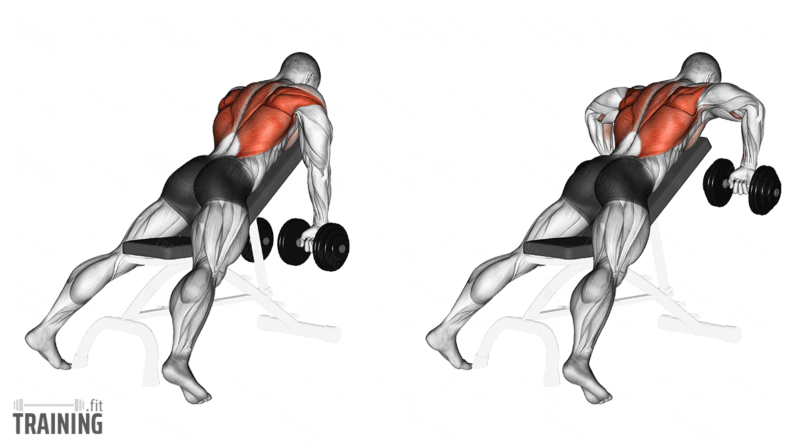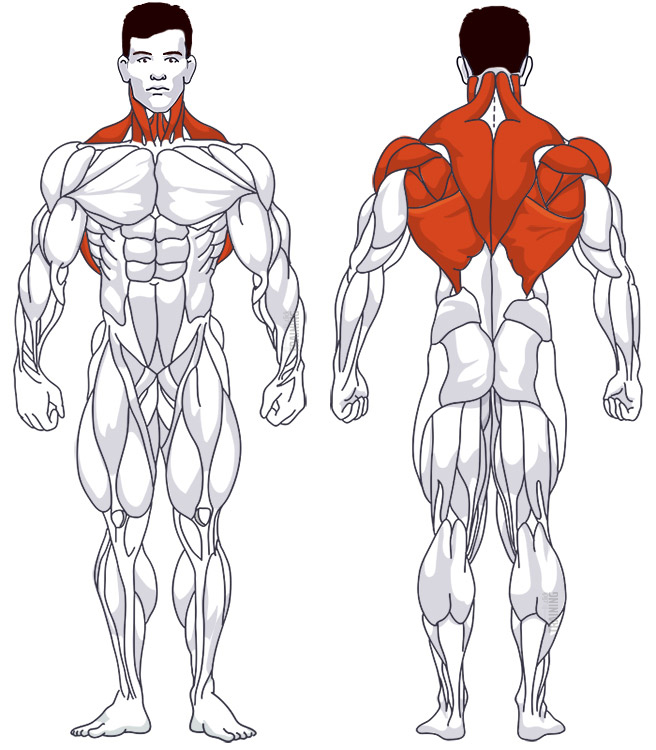Incline Dumbell Row
Compound exercise, Free weightsOverview

Main muscles
- Neck: Trapezius muscle
(Musculus trapezius) - Back: Fascia in the lumbar region
(Fascia thoracolumbalis) - Back: Large round muscle
(Musculus teres major) - Back: Large back muscle
(Musculus latissimus dorsi) - Back: Larger rhomboid muscle
(Musculus rhomboideus major) - Back: Small round muscle
(Musculus teres minor) - Shoulder: Posterior deltoid muscle
(Musculus deltoideus, posterior deltoid muscle)
Training plans
Here you can find example plans for incline dumbell row training:
Incline Dumbell Row: Basics and alternatives

Involved main muscle groups:
Incline Dumbell Row
Most people do barbell rows with a forward lean. However, this requires stabilization of the lower back. If you’d prefer better isolation during the movement, then the Incline Dumbbell Row is a great alternative. Instead of standing freely, you lie down on an incline bench with your stomach, which takes the pressure off your lower back.
The movement is pretty similar to the classic barbell row: you pull the weight towards your upper body, and your elbows pass by your body sideways. The focus is on the upper back, as well as the neck and rear shoulder.
The rowing machine is a smart alternative that allows for even stronger isolation due to the guidance.
Correct execution
When it comes to incline exercises, there’s no one-size-fits-all rule for the angle of the incline bench for the Incline Dumbbell Row. Anything between 40 and 70 degrees can work, depending on your body type. Choose an angle that gives you enough space to hang your arms and isn’t so steep that you’re almost standing upright.
The grip you choose can help vary the muscle focus. An underhand grip and parallel or hammer grip will activate the lats more, with increased biceps support. The hammer grip puts more focus on the neck, while an overhand grip targets the rear shoulder more.
There’s no right or wrong grip variant. Depending on your desired muscle focus and which option suits your anatomy best, feel free to choose the grip you prefer.
Video tutorial
Step-by-step instructions
Grab the dumbbell and walk towards the incline bench, facing it.
Lie face down on the incline bench. Rest your chin at the end of the bench. Stabilize your body by positioning your feet shoulder-width apart behind you.
Let your arms hang down with the dumbbell in your chosen grip variant. This is your starting position.
Pull the dumbbells up towards your upper body. Your elbows should pass close to your body. Then lower the dumbbells back down to the starting position in a controlled manner.
Common mistakes
Try to make the most of the exercise’s full range of motion. Since your body is stabilized in the lying position and your lower back is supported, you can move the weights farther forward/down without losing balance. Use this to make your training as efficient as possible.
At the same time, be careful not to choose a weight that’s too heavy. Focus on clean execution without using momentum. Perform the full movement consciously, even if the weight seems light at first, and don’t go too fast. Remember, this isn’t a cardio exercise.